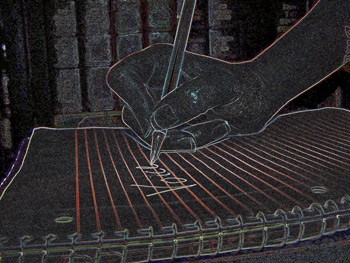
Photograph by Brian Scott Casey
Dialogue, simply put, is the VOICE of your characters. It is the words that they speak. What does this have to do with place, you ask?
The answer is, just about everything. From a practical standpoint, people speak differently depending on where they are from. They have accents, speak in dialects, make particular word choices (syntax), follow or break the rules of grammar, use slang. When someone speaks, you can often infer what part of the world they live in merely by the sound of their voice.
Looking deeper

Photograph by Brian Scott Casey
Beyond accent and dialect, I have recently discovered that when it comes to writing fiction there is a much more profound connection between voice and place. By connecting the two, you can find your way deeper into your characters, and in turn they will lead you deeper into your story.
For the past 8 weeks, I have been taking an online course through the Iowa Writer’s Workshop called, “How Writers Write Fiction”. One lesson was titled, “Putting Setting to Work”. Given my deep and abiding passion for PLACE, I was extremely excited to dig in to what I assumed would be a tutorial on writing setting description. (For tips on writing compelling setting description, check out How to Put Place on Paper.)
Imagine my surprise when the lesson focused on dialogue. I immediately felt myself resisting. “What does this have to do with setting?” I asked myself.
Language as a conduit for PLACE

Photograph by Brian Scott Casey
Soon, I began to see that it was through language that my characters interacted with the world I had built from them. Respectively, it is through the particular nature of the places we are in that we can come to see the universal qualities of our world.
For my assignment, I decided to work on a story for the collection of short fiction I am writing. The story is set along a bayou in Bay St Louis, MS. As I wrote dialogue for the characters I had placed in that setting, I tried to imagine how they saw the world because of the place they were in. When they spoke, their lives reflected in the surface of the water. Their voices rose above the whisper of the marsh grass, and their stories grew in the place that I planted them.

Photograph by Brian Scott Casey
Clearly, southern Mississippi has its own particular dialect. This was reflected in my character’s voices, of course, as one would expect. But when I wrote the dialogue within the context of this exercise, there was more than that. My characters spoke with the weight of the story, expressing themes and reinforcing their connection to the PLACE they were in.
Doing this writing exercise allowed my story to grow into so much more than it would have been otherwise. A character that may have been cut later on became an integral part of the story. My characters came alive with strong, distinct voices of their own. They were rooted in place, and everything that happened in the story from that point on seemed to rise inevitably from the setting.
Let your characters speak for themselves

Photograph by Brian Scott Casey
Dialogue is a fantastic opportunity for your characters to tell their own story. Let them say what they need to. Let the voice of the character drive the story where it needs to go.
Root your characters in place, and let them speak from there. Let the setting act as another character in your story, and through dialogue allow your characters to interact with each other.
Try the exercise yourself!
“Think about a place you know. Think about the people from there. Think about the rhythm of their conversation, accents, the way they talk, and the way they occupy their environment.
In no more than 400 words, write a scene with dialogue where you bring character and setting together. Remember, people make place and places make people.”
Finding your voice

Photograph by Brian Scott Casey
I encourage you to try this exercise for yourself. Work on a story you’re already writing, expand the seed of some idea you’ve been meaning to explore, or write something entirely new.
Think about how voice is connected to the place a character is in. How can a sense of setting be conveyed through dialogue? How do the perspectives of the different characters color the way we perceive that place?
Build a world and put some characters in it. What do they have to say? Find out on the page.
Tips for writing dialogue

Photograph by Brian Scott Casey
Writing good dialogue is hard work. Dialogue should read in a way that seems natural, but in truth it is a strange hybrid between spoken and written language. We cannot write speech as it is spoken, or it wouldn’t make any sense.
People speak in fragments. They change course. They veer this way and that. Stop. Start again. Its frustrating and imperfect on the page.
Writing dialogue well requires a few special considerations. Follow these tips below for crafting believable dialogue.
- Use syntax (word choice) rather than misspelling and excessive apostrophes. This is especially true when writing characters with a strong Southern dialect, or any other strong accent which might lead you to write words in a nonstandard way. Dialogue written this way is difficult to read, and pulls the reader out of your story as they try to work out what your characters are saying. A better technique is to show a distinctive voice through the particular words that the character uses. The sound and the rhythm convey the dialect without creating confusion.
- Dialogue tags Sometimes it’s ok to go with the old standby, he said, she said when it comes to writing dialogue tags. While it’s ok to change it up periodically, an over indulgence of alternatives can overwhelm the dialogue itself as the character yells, sighs, argues, or swallows words. Another way to break up the use of dialogue tags is to drop them completely on some lines. Write some action. A description. A movement for your character. This also helps keep the story moving forward.
- Write what you know Try to avoid writing a highly specific dialect unless you are familiar with it. If you write a story set in a place with a very particular voice, go there and listen to people speak. Listen to the way their voices sound and what words they use. Write them down. This will give you a better feel for the dialect and allow you to write it more convincingly.
Share your journey

Photograph by Brian Scott Casey
If you do the writing exercise and would like to share what you learn, feel free to post in the comments below! I would love to hear about it!
Don’t forget to follow me in LOCUS: A journey in search of PLACE!
Resources
Pingback: Words Spring Forth | LOCUS
Hello Kerri
This is my first time here in your blog, and from what I’ve seen so far, it is very impressive.
I did have to smile when I read your article about writing dialogue, especially for a character from a setting that takes place in some other part of the country. Like you, I also went through the HWWF course, and I remember that assignment very well. I think I could almost say that it gave me nightmares from the problems I had. What I did for my short story for that assignment and the next two lessons, was to take a character that had lived all his life in New York City and have him go down to Mississippi to spend some vacation time with a friend and the friends parents. I’ve never lived in that part of the country, so when it came time to include a little dialogue, I tried to ‘fake it’ using what I thought would sound appropriate. Well, needless to say, it didn’t work. 🙂 Some of my classmates knew a lot more about the southern dialect than I did and they pointed this out to me.
That was a wonderful course and I learned a lot from it. For people interested in writing, I’d recommend that they enroll in the upcoming course this spring.
Stan (AKA HopefullAuthor)
LikeLike
Reblogged this on Iqra Writes and commented:
Tips on writing dialogue.
LikeLiked by 1 person
Reblogged this on Through his eyes… and commented:
Finding VOICE in Place.
LikeLike
Kerri , this is so very helpful …Thankyou for your generosity of spirit in sharing …xx
LikeLike
Meg, I am so glad you found it helpful! Thank you for visiting and reading!
LikeLiked by 1 person